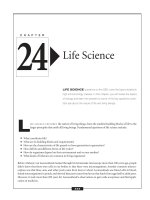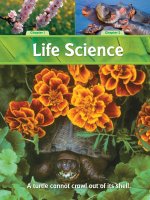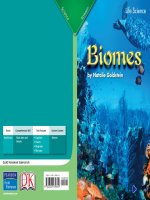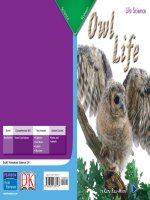Animal helpers (life science)
Bạn đang xem bản rút gọn của tài liệu. Xem và tải ngay bản đầy đủ của tài liệu tại đây (3.58 MB, 12 trang )
Suggested levels for Guided Reading, DRA,™
Lexile,® and Reading Recovery™ are provided
in the Pearson Scott Foresman Leveling Guide.
Life Science
by Marianne Lenihan
Genre
Narrative
nonfiction
Comprehension
Skills and Strategy
• Cause and Effect
• Fact and Opinion
• Monitor and Fix Up
Text Features
•
•
•
•
Captions
Headings
Labels
Glossary
Scott Foresman Reading Street 2.3.3
ISBN 0-328-13270-5
ì<(sk$m)=bdchag< +^-Ä-U-Ä-U
Think and Share
Read Together
1. What animals can cause disease? What
effect can bats, owls, and cats have on
these animals?
2. Was there anything in this book that
you found hard to understand? Tell
about it. What did you do to help
yourself figure
it out?Lenihan
by Marianne
3. Make a chart like the one below. In
one column, list all the domesticated
animals that you can think of. In the
other, list wild animals.
Domesticated
Wild
4. Of all the animal helpers named in this
book, which do you think is the most
important? Why?
Editorial Offices: Glenview, Illinois • Parsippany, New Jersey • New York, New York
Sales Offices: Needham, Massachusetts • Duluth, Georgia • Glenview, Illinois
Coppell, Texas • Ontario, California • Mesa, Arizona
Animals and people have shared Earth for
thousands of years. Some animals are wild.
You have probably seen wild animals, such as
birds, in your backyard. Other animals, such as
cows, are domesticated. Domesticated animals
were once wild too. People slowly trained wild
animals to live with them. The animals became
domesticated. These animals are raised by
people for food or other materials.
Wild animals and domesticated animals
can help people. Some animals supply people
with food, such as milk or honey, while other
animals supply useful materials, such as wool.
Every effort has been made to secure permission and provide appropriate credit for
photographic material. The publisher deeply regrets any omission and pledges to
correct errors called to its attention in subsequent editions.
Unless otherwise acknowledged, all photographs are the property of Scott Foresman,
a division of Pearson Education.
What animals did these
items come from?
Milk
Photo locators denoted as follows: Top (T), Center (C), Bottom (B), Left (L), Right (R),
Background (Bkgd)
Opener: Corbis, ©DK Images; 1 ©DK Images; 3 ©DK Images; 4 Corbis; 5 ©DK Images;
7 ©DK Images; 8 ©DK Images; 9 ©DK Images; 11 ©DK Images, Peter Arnold, Inc.;
12 ©DK Images; 13 Getty Images; 15 Digital Vision; 16 ©DK Images; 17 Digital Vision;
18 ©DK Images; 19 Brand X Pictures
Honey
ISBN: 0-328-13270-5
Copyright © Pearson Education, Inc.
All Rights Reserved. Printed in the United States of America. This publication is
protected by Copyright, and permission should be obtained from the publisher
prior to any prohibited reproduction, storage in a retrieval system, or transmission
in any form by any means, electronic, mechanical, photocopying, recording, or
likewise. For information regarding permission(s), write to: Permissions Department,
Scott Foresman, 1900 East Lake Avenue, Glenview, Illinois 60025.
2 3 4 5 6 7 8 9 10 V010 14 13 12 11 10 09 08 07 06 05
Yarn
3
Cows
If you drank a glass of milk today, it
probably came from a cow. Female cattle, or
cows, can produce milk. The milk from the
cows is then bottled and sent to the grocery
store for you to buy. People consume, or eat,
milk and milk products every day.
Some milk is not bottled right away. It is
used to make other products that have milk
in them. The products that people make from
milk are called dairy foods. Some dairy foods
that you may consume include butter, cheese,
yogurt, and ice cream.
Which dairy food is your
favorite?
Yogurt
Cheese
Milk
4
5
Sheep
Sheep are domesticated animals that can
help people by supplying wool. Sheep grow
a thick coat that keeps them warm in the
winter. When spring comes, their wool coats
become too warm for them and they need a
summer haircut!
Sheep owners shear their sheep. This
means that they clip off all the sheep’s thick
winter wool. Shearing does not harm the
sheep—it helps them stay cool. Then the sheep
owners gather the wool into bags.
This farmer is
shearing a sheep.
The sheep’s
wool will be
made into yarn.
The yarn will be
made into clothing
and blankets.
6
7
Bats
Have you ever seen a bat? If you have,
you probably saw it flying in the late evening.
That’s the time when bats wake up and start
looking for food.
Bats cannot see very well, so they use
a special sense to figure out what’s ahead
of them as they fly. This sense, called
echolocation, helps bats find their food. How
does it work? As a bat flies, it makes highpitched sounds. These sounds bounce off
objects and come back to the bat. That is how
the bat is able to tell exactly where it is and
where its next tasty prey can be found!
Bats help people because of their great
hunting skills. In a single night, a very
shrewd bat can catch thousands of insects!
Bats help people by eating insects, such as
mosquitoes, that may carry diseases.
Some types of bats live in
large cave colonies.
8
9
Honeybees
Many people are afraid of bees because
they are insects that can sting, but bees can
help people in many ways.
If you have ever tasted honey, you
already know about one way in which bees
help people. Sweet syrupy honey is made by
honeybees. Honeybees also make beeswax.
Beekeepers raise honeybees and sell honey
and beeswax. Beekeepers have to be very
careful when they are working with the bees.
They wear special clothing and a wire net
over their faces to protect them from stings.
Honeybees live on
frames in specially
built hives. They
make honeycombs
on the frames.
A beekeeper removes
some frames from the
hive. The beekeeper
does not hurt the
honeybees.
A machine separates the beeswax
from the honey. The beekeeper can
sell the honey. Candlemakers can
make candles from the beeswax.
10
11
Honeybees and other insects also help
by spreading pollen. Bees fly from flower to
flower, gathering nectar. Nectar is the sweet
liquid that is found in many flowers, and bees
use it to make honey.
Pollen looks like yellow chalk dust. It
sticks to the bees’ bodies. When a bee lands
on a new flower, some of the pollen falls off.
Spreading pollen helps make new plants.
Without bees, we would have fewer flowers!
Wildflowers
Pollen gets stuck
to the bees as they
gather nectar.
12
13
Birds
Many people like to have birds nearby.
Some people feed birds, or they have birdbaths
in their yards so that the birds can have water
to drink. Other people work very hard to keep
birds that are becoming extinct alive and safe.
One reason for this is that, just like bees,
birds can carry pollen from one flower to
another. Other birds spread seeds from
berries or fruit that they eat. New trees and
flowers can grow because birds spread pollen
and seeds.
Birds can help people in other ways too.
Like bats, owls help people by hunting. They
catch rodents, such as mice and rats. Rodents
can carry diseases, and owls help to keep
these diseases from becoming a danger.
Owl
Hummingbird
14
15
Barn cat
Animals can help people in many different
ways. Some animals help by producing food or
other useful materials. Some animals keep pests
away or help new plants to grow. Without
these animals, people’s lives would be very
different. Next time you are outside, keep your
eyes open and look for animal helpers!
Barn Cats
Do you have a pet cat at home? Barn cats
are different from house cats because they live
outdoors on farms. Barn cats are not usually
as tame as house cats. Barn cats are kept by
farmers because they are excellent hunters.
Barn cats help farmers by eating rodents.
That way, rodents do not eat the farmer’s stored
crops. Barn cats also keep diseases carried by
rodents away from the other farm animals.
16
17
Now Try This
Animals That Help in My
Neighborhood
You have read about many different
animal helpers in this book. Now you’ll have
a chance to research the animals that help in
your environment. Follow these steps.
to Do It!
w
o
H
s
’
e
r
He
1. Spend some time outdoors in your
neighborhood.
2. Look for different animals. Take a
notebook with you to make notes about
the animals you see.
3. Learn more about these animals from
books or by using the Internet. Which of
these animals are animal helpers?
4. Make a poster to show what you have
discovered. Use words and pictures to
explain your ideas.
5. Display your poster in a place where
others can learn from it.
How Can
Horses Help?
18
19
Glossary
consume v. to eat
or drink.
dairy adj. made
with milk.
domesticated adj.
changed from wild
to tame by people.
echolocation n.
the use of sound to
sense location.
Think and Share
prey n. an animal
that is hunted or
eaten by another
animal.
rodents n. small
mammals with
large front teeth
for gnawing, or
chewing.
shrewd adj. smart,
clever.
Read Together
1. What animals can cause disease? What
effect can bats, owls, and cats have on
these animals?
2. Was there anything in this book that
you found hard to understand? Tell
about it. What did you do to help
yourself figure it out?
3. Make a chart like the one below. In
one column, list all the domesticated
animals that you can think of. In the
other, list wild animals.
Domesticated
Wild
4. Of all the animal helpers named in this
book, which do you think is the most
important? Why?
20









